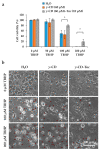Development of Water-Insoluble Vehicle Comprising Natural Cyclodextrin-Vitamin E Complex
- PMID: 33804761
- PMCID: PMC8003986
- DOI: 10.3390/antiox10030490
Development of Water-Insoluble Vehicle Comprising Natural Cyclodextrin-Vitamin E Complex
Abstract
Development of a novel antioxidant-delivery vehicle exerting biosafety has been attracting a great deal of interest. In this study, a vehicle comprising a natural composite consisting of vitamin E (α-tocopherol; Toc) and cyclodextrin (CD) additives was developed, directed toward aqua-related biological applications. Not only β-CD, but also γ-CD, tended to form a water-insoluble aggregate with Toc in aqueous media. The aggregated vehicle, in particular the γ-CD-added system, showed a remarkable sustained effect because of slow dynamics. Furthermore, a prominent cytoprotective effect by the γ-CD-Toc vehicle under the oxidative stress condition was confirmed. Thus, the novel vitamin E vehicle motif using γ-CD as a stabilizer was proposed, widening the usability of Toc for biological applications.
Keywords: cell viability; oxidative stress; radical scavenging; vehicle; vitamin E; γ-cyclodextrin.
Conflict of interest statement
The authors declare no conflict of interest.
Figures





Similar articles
-
Clarification of the Complexation Behaviour of 2,6-di-O-Methylated β-Cyclodextrin and Vitamin E and Radical Scavenging Ability of the Complex in Aqueous Solution.J Oleo Sci. 2021 Oct 5;70(10):1461-1467. doi: 10.5650/jos.ess21064. Epub 2021 Sep 8. J Oleo Sci. 2021. PMID: 34497177
-
Influence of cyclodextrin complexation on the photodegradation and antioxidant activity of alpha-tocopherol.Pharmazie. 2004 Jan;59(1):30-3. Pharmazie. 2004. PMID: 14964418
-
Kinetic study of the radical-scavenging activity of vitamin E and ubiquinone.In Vivo. 2005 Nov-Dec;19(6):1005-11. In Vivo. 2005. PMID: 16277014
-
The Physiological Roles of Vitamin E and Hypovitaminosis E in the Transition Period of High-Yielding Dairy Cows.Animals (Basel). 2021 Apr 11;11(4):1088. doi: 10.3390/ani11041088. Animals (Basel). 2021. PMID: 33920342 Free PMC article. Review.
-
Safety assessment of gamma-cyclodextrin.Regul Toxicol Pharmacol. 2004 Jun;39 Suppl 1:S3-13. doi: 10.1016/j.yrtph.2004.05.008. Regul Toxicol Pharmacol. 2004. PMID: 15265610 Review.
Cited by
-
Complexes of Fat-Soluble Vitamins with Cyclodextrins.Int J Mol Sci. 2025 Jun 25;26(13):6110. doi: 10.3390/ijms26136110. Int J Mol Sci. 2025. PMID: 40649885 Free PMC article. Review.
-
Cell Death via Lipid Peroxidation and Protein Aggregation Diseases.Biology (Basel). 2021 May 4;10(5):399. doi: 10.3390/biology10050399. Biology (Basel). 2021. PMID: 34064409 Free PMC article. Review.
-
Cyclodextrins and their potential applications for delivering vitamins, iron, and iodine for improving micronutrient status.Drug Deliv Transl Res. 2025 Jan;15(1):26-65. doi: 10.1007/s13346-024-01586-x. Epub 2024 Apr 26. Drug Deliv Transl Res. 2025. PMID: 38671315 Review.
-
Determining the rates of α-tocopherol movement in DPPC vesicles using small-angle neutron scattering.Biophys J. 2025 Feb 18;124(4):590-596. doi: 10.1016/j.bpj.2025.01.008. Epub 2025 Jan 17. Biophys J. 2025. PMID: 39827369
-
Mechanism and Multilayer Perceptron prediction model of the removal of α-terpineol, terpinen-4-ol and carvone from pasteurized citrus juices by β-cyclodextrin encapsulation.Front Nutr. 2025 May 21;12:1557934. doi: 10.3389/fnut.2025.1557934. eCollection 2025. Front Nutr. 2025. PMID: 40469671 Free PMC article.
References
-
- Niki E., Abe K. Vitamin E: Structure, properties and functions. In: Niki E., editor. Food Chemistry, Function and Analysis No. 11 Vitamin E: Chemistry and Nutritional Benefits. The Royal Society of Chemistry; London, UK: 2019. pp. 1–11. Chapter 1. - DOI
Grants and funding
LinkOut - more resources
Full Text Sources
Other Literature Sources

